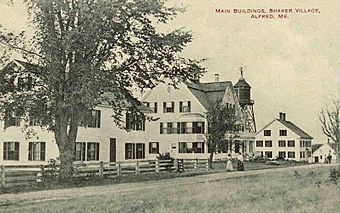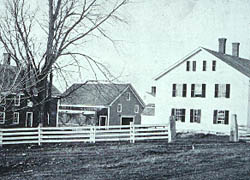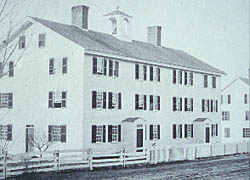Alfred Shaker Historic District facts for kids
Quick facts for kids |
|
|
Alfred Shaker Historic District
|
|

Main buildings, Shaker Village; from a 1915 postcard
|
|
| Location | Shaker Hill Road. Alfred, Maine |
|---|---|
| Architectural style | Federal |
| NRHP reference No. | 01000371 |
| Added to NRHP | April 11, 2001 |
| Community | Alfred Shaker Historic District |
|---|---|
| Dates | 1793-1931 |
| Bishopric | Alfred |
| Spiritual name | Holy Ground |
| Families | Church, Second, North |
| Maximum population | 200 in 1823 |
The Alfred Shaker Historic District is a special historical area in Alfred, Maine. It includes buildings and land on both sides of Shaker Hill Road. This place was once home to the oldest and largest Shaker community in Maine.
The Shakers were a religious group known for their simple lifestyle and unique beliefs. They lived together in communities, sharing everything. The Alfred Shaker community officially started in 1793. It became a very important center for Shakers in Maine.
One famous Shaker, Joseph Brackett, is believed to have written the well-known song Simple Gifts here. The Shakers were also known for their care of the sick.
The village closed in 1931 because fewer people joined the community. Also, their handmade products could not compete with factory-made goods. The remaining Shakers moved to Sabbathday Lake Shaker Village, another Shaker community in Maine.
Today, the Alfred Shaker Historic District is recognized for its importance. It was added to the National Register of Historic Places in 2001. The Shaker Village Museum helps keep the Shaker story alive for everyone.
After the Shakers left, the land and buildings were bought by the Brothers of Christian Instruction. They now use the site as the Notre Dame Spiritual Center.
Contents
Exploring the Shaker Village
The Shakers' Story in Alfred
The Shaker story in Maine began in 1783 with John Cotton. He was inspired by Mother Ann Lee, a leader of the Shaker faith. Soon after, Shaker members settled on a hill near what is now Shaker Pond. People sometimes called them "Merry Dancers" because of their lively worship.
The Shaker village was officially formed in 1793 when they built a meetinghouse. The Shakers believed in living a simple, communal life. This meant everyone lived together and shared their resources. They also believed in equality for all people, regardless of gender or race. Their buildings and furniture were plain and practical, reflecting their faith.
At its peak in the 1840s, the Shaker movement had 19 communities. These villages stretched from Maine all the way to Kentucky and Indiana. Each community was part of a larger organization called a bishopric. Alfred was home to the main leaders, called elders and eldresses, for the Maine bishopric. These leaders visited other Shaker villages in Maine to guide them.
In 1848, Elder Joseph Brackett and Eldress Rebecca Hodgdon were important leaders in Alfred. Many Shakers believe that Elder Joseph Brackett wrote the famous dancing song Simple Gifts around this time.
Hundreds of people lived in the Alfred Shaker village. It covered 300 acres on both sides of Shaker Hill Road. The village had many important buildings, including a school, gardens, orchards, and mills. They also had barns, a dairy, and various shops.
The Shakers were skilled craftspeople. They made many useful items like brooms, brushes, and woven cloth. They also produced woodenware, spinning wheels, and herbal medicines. Their main goals were to live simply, respect nature, and create high-quality products. While they made many goods, the village struggled financially. It was hard to compete with products made in factories.
By the late 1800s, the number of Shaker members in Alfred began to decrease. Most of the remaining members were devoted women. In 1920, there was an effort to attract new members, which brought new energy to the community for a few years.
However, by March 1931, only a few Shakers remained in Alfred. They eventually moved to the Sabbathday Lake Shaker Village. Today, the Alfred Shaker Historic District is preserved as a historical site. The Sabbathday Lake Shaker Village in New Gloucester is the only active Shaker community left. Other former Shaker villages, like Alfred, now operate as museums.
Artist Joshua Bussell lived in the Alfred community for a long time.
The Alfred Shaker Museum
The Alfred Shaker Museum helps share the history of the Shakers. It is located in a former gatehouse of the old Shaker village. Local residents started the "Friends of Alfred Shaker Museum" to protect this important heritage.
The museum has a library, a shop, and exhibits. It also hosts craft workshops and special events. These activities help visitors learn about the Shaker way of life.
The Notre Dame Spiritual Center
In 1931, after the Shakers left, the Brothers of Christian Instruction bought the Alfred property. They renamed it the Notre Dame Spiritual Center.
The Brothers have continued to care for the farm and use the village buildings. Some of the Shakers' old apple orchards and blueberry fields still produce fruit. Selling this fruit helps support the York County Shelter, a local charity.
See also



